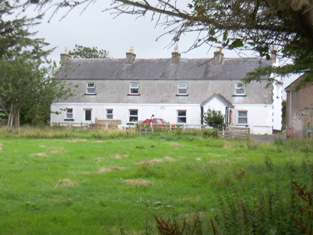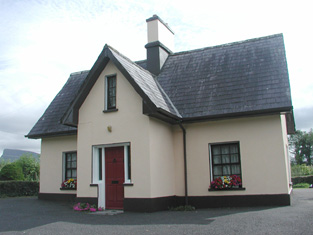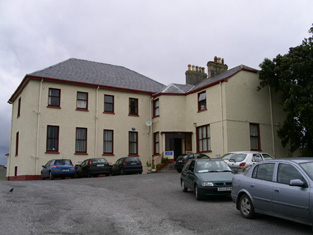Raghly Lodge
Houses within 10km of this house
Displaying 25 houses.
Houses within 10km of Raghly Lodge
Displaying 25 houses.
| House name | Description | |
|---|---|---|
| Lissadell or Lissadill | The Gore Booth family built the first Lissadell House between 1750-1760, in front of the current house. The current house was built in the late eighteenth and early nineteenth century and continued to be the home of the Gore Booth family until the 1990s. In 1906 the house and buildings were valued at £347. The house has been open to the public for many years. It is now owned by E. Walsh and C. Cassidy and is being restored. See www.lissadellhouse.com. |

|
| Streedagh | It is likely that Thomas Jones built a house at Streedagh c 1725. However, the present house dates from the early years of the nineteenth century. In 1906 it was the property of Richard W. Jones and was valued at £18. It is still extant and occupied. |

|
| Culleenamore | At the time of Griffith's Valuation, Samuel Barrett was leasing the house at Culleenamore, barony of Carbury, from Edward Nicholson, when it was valued at £16. | |
| Rathcarrick | At the time of Griffith's Valuation there were two substantial houses at Rathcarrick, barony of Carbury, both belonging to the Walker estate. John McHutcheon was leasing one property valued at £18 while Amy Eliza Walker was leasing the second, valued at £28. In 1906 John F. Walker was the owner of a house at Rathcarrick, then valued at £63. Rathcarrick house is still extant and has recently been renovated. |

|
| Port Royal | At the time of Griffith's Valuation, Henry Griffith was leasing a property at Buninna, including a mill from the Cooper estate. The property was valued at £12. McTernan notes that this house is described in early nineteenth century documents as a "marine villa". It was later occupied by the McMunn and Hart families. It is stil extant but dilapidated. | |
| Toberpatrick (Skreen) | Wilson, writing in 1786, refers to "Tubberpatrick" as the seat of Captain Jones. In 1837 Lewis recorded Tubberpatrick House as a seat of the Jones family. At the time of the estate sale in the Encumbered Estates court in April 1852, the house at Tubberpatrick was described as "a dwelling house fit for the reception of a gentleman, with offices and garden on the demesne". At the time of Griffith's Valuation it was the property of Peter O'Connor and was valued at £15. Toberpatrick House is still extant and occupied. In 2008 it was offered for sale through Knight Frank estate agents [Irish Times, 13 March 2008]. |

|
| Seafort House | At the time of Griffith's Valuation, Richard Wood was leasing a property valued at £14 at Carrowbrickeen, barony of Tireragh, from the representatives of Arthur Cooper. Lewis records Seafort House as a residence of the Wood family in 1837. In 1814 it was the seat of Richard Wood. McTernan notes that Seafort House was demolished in the twentieth century and a modern house stands at the site. | |
| Corkhill House | Sir Malby Crofton is recorded as the lessor of two properties in the parish of Templeboy at the time of Griffith's Valuation. One property is noted as a herd's house, valued at £1 while the second, valued at £1 5s, was leased to Thomas Fury. McTernan notes that in the eighteenth century this house had been leased from the Crofton estate by the Wood family. It eventually fell into disrepair and was demolished. | |
| Ardtermon Castle | Ardtermon was the first property held by the Gore family before the building of Lissadell. McTernan notes that it was granted to Sir Francis Gore and had previously been the property of the O'Hart family. The Gore Booth family moved to Lissadell in the mid eighteenth century. Since 1979 it has been the home of the Schiller family who have restored it to its former glory from total ruin. See www.ardtarmoncastle.com |

|
| Doonaleragh Lodge | This house was built as a summer house for the family residing at Rathcarrick. At the time of Griffith's Valuation, Amy Eliza Walker was leasing it and over 300 acres from the representatives of Roger Walker. It was valued at £10. It is still extant and occupied. |

|
| Dirk Lodge | Alexander Crichton's address is given as Dirk Lodge, Drumard, in 1870s Landowners Listings. In the 1850s the house is described as a "steward's house" valued at £8. In 1906 he was the owner of a house valued at £8 at Derk Beg, barony of Tireragh. McTernan notes that this property had been a herd's house in the early ineteenth century but was enlarged in the 1880s. It is still extant and occupied. |

|
| Finned House | In 1906 Sir Jocelyn Gore Booth owned buildings valued at £8 at Finned, barony of Carbury. This is likely to be Finned House. This townland was the property of the Gore Booth estate at the time of Griffith's Valuation but the highest building valuation at that time was only £2. | |
| Ballygilgan Gate Lodge | In 1906 Sir Jocelyn Gore Booth held over 800 acres of untenanted land at Ballygilgan as well as a house valued at almost £9. |

|
| Elsinore | At the time of Griffith's Valuation, Edward Cooper owned a property at Rosses Upper, barony of Carbury, valued at £16. In 1906 the representatives of William Middleton held a property here valued at £18 as well as over 350 acres of untenanted land. The property also has associations with W.B. Yeats who used to spend holidays here with the Middleton family. The house is now a ruin. |

|
| Cregg House | Michael Jones, formerly of Lisgoole, county Fermanagh, is described as of Cregg House in 1854. His representatives still held the property in the 1870s. At the time of Griffith's Valuation, it was occupied by Capt. Alex Lumsden, son-in-law of Michael Jones, leasing from John Wynne, when it was valued at £25. Cregg House afterwards came into the possession of the Sisters of La Sagesse and is now a Special Needs facility. |

|
| Castle Lodge | At the time of Griffith's Valuation, Richard Beatty was leasing a property valued at £6 from the Fury estate at Ballinphull, barony of Tireragh. McTernan notes that the Fury/Furey family owned this property up to the end of the nineteenth century but did not live there. The Ordnance Survey Field Name Books refer to Castle Lodge as "a handsome cottage in good repair". The house was burned during the Civil War but subsequently repaired. It is still extant but in disrepair. | |
| Rahelly | Francis Barber was leasing a house at Rahelly, barony of Carbury, from the Gore Booth estate at the time of Griffith's Valuation, when it was valued at £25. Rahelly later fell into ruin but has been restored and offered for sale in recent times. |

|
| Mount Edward Cottage | Both the Ordnance Survey Field Name Books and Griffith's Valuation record a property at Mount Edward as belonging to Capt. James Jones. It had a valuation of £2 in the 1850s. This would appear to be the property named as Mount Edward Cottage on the 1st edition OS map. McTernan states that it was occupied by the Hood family from the mid-nineteenth century until the 1980s. It is now in a dilapidated state. | |
| Oxfield | At the time of Griffith's Valuation, Oxfield House was the caretaker's residence for the plantation of over 150 acres owned by the Gore Booth estate at Cullaghmore, barony of Carbury. | |
| Highpark House | At the time of Griffith's Valuation, James Dowdican was leasing property from the Webber estate in the parish of Skreen including a house valued at £2 at Carrowgilhooly. This may be the property named as Highpark House both on the First and 25-inch editions Ordnance Survey Maps. There is still a house extant on the site. | |
| Strandhill House | At the time of Griffith's Valuation George D. Meredith was leasing Strandhill House, valued at £9, from the estate of William Phibbs. McTernan states that the house remained in the Meredith family until the 1960s. It is now a roofless ruin. | |
| Rockville (Carbury) | Edward Homan was leasing two properties, both valued at over £4 and described as Bathing Lodges, at Culleenamore, from Samuel Barrett, at the time of Griffith's Valuation. One house is noted on the OS 1st edition sheet as Rockville and the second as Bocage. | |
| Moorfield Cottage | Jeremiah Rogers, a steward on the Gore-Booth estate, was occupying this property at the time of Griffith's Valuation, when it was valued at £5 10s. McTernan states that it remained in the Rogers family until the early decades of the twentieth century. It is still extant and occupied. | |
| Urlar or Beckfield | Leased by William Hamilton,MD, from the Gore-Booth estate at the time of Griffith's Valuaiton when it was valued at over £10. McTernan notes that it was previously held by the Munns family and later in the nineteenth century by George Somerville. Labeled as Beckfield on the First Edition Ordnance Survey Map. It is still extant and undergoing restoration. | |
| Ardnaglass | Wilson, writing in 1786, refers to Ardnaglass as the seat of Mr. Jones, "half a mile beyond the ruins of a castle". The castle he refers to is Ardnaglass Castle, also associated with the Jones family. Earlier, in 1739, Reverend William Henry mentions Ardnaglass as the seat of Loftus Jones. By the time of Griffith's Valuation, this townland was part of the Webber estate, leased by William Graham. He was occupying a property valued at £4. The castle ruins are still extant. |

